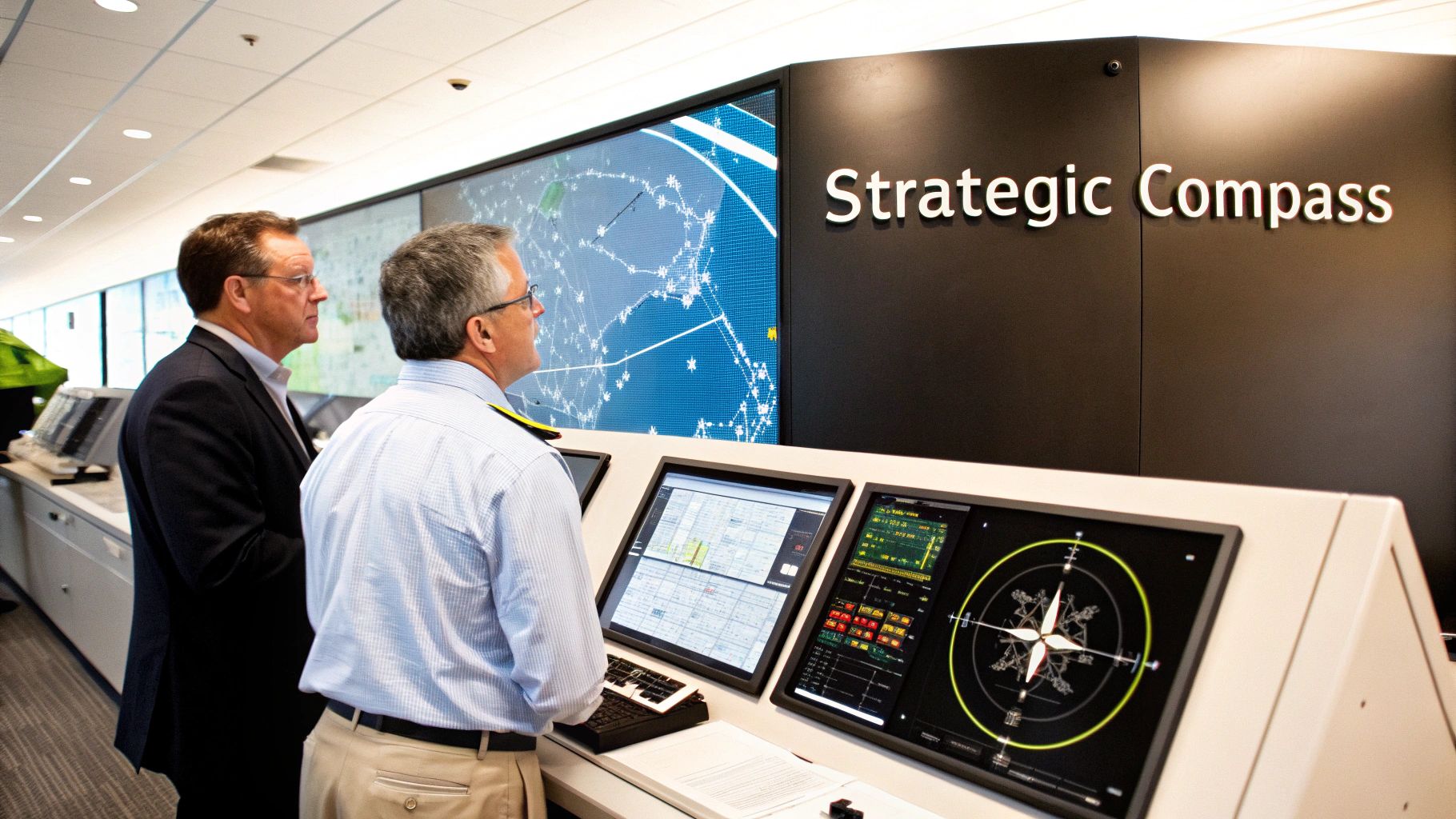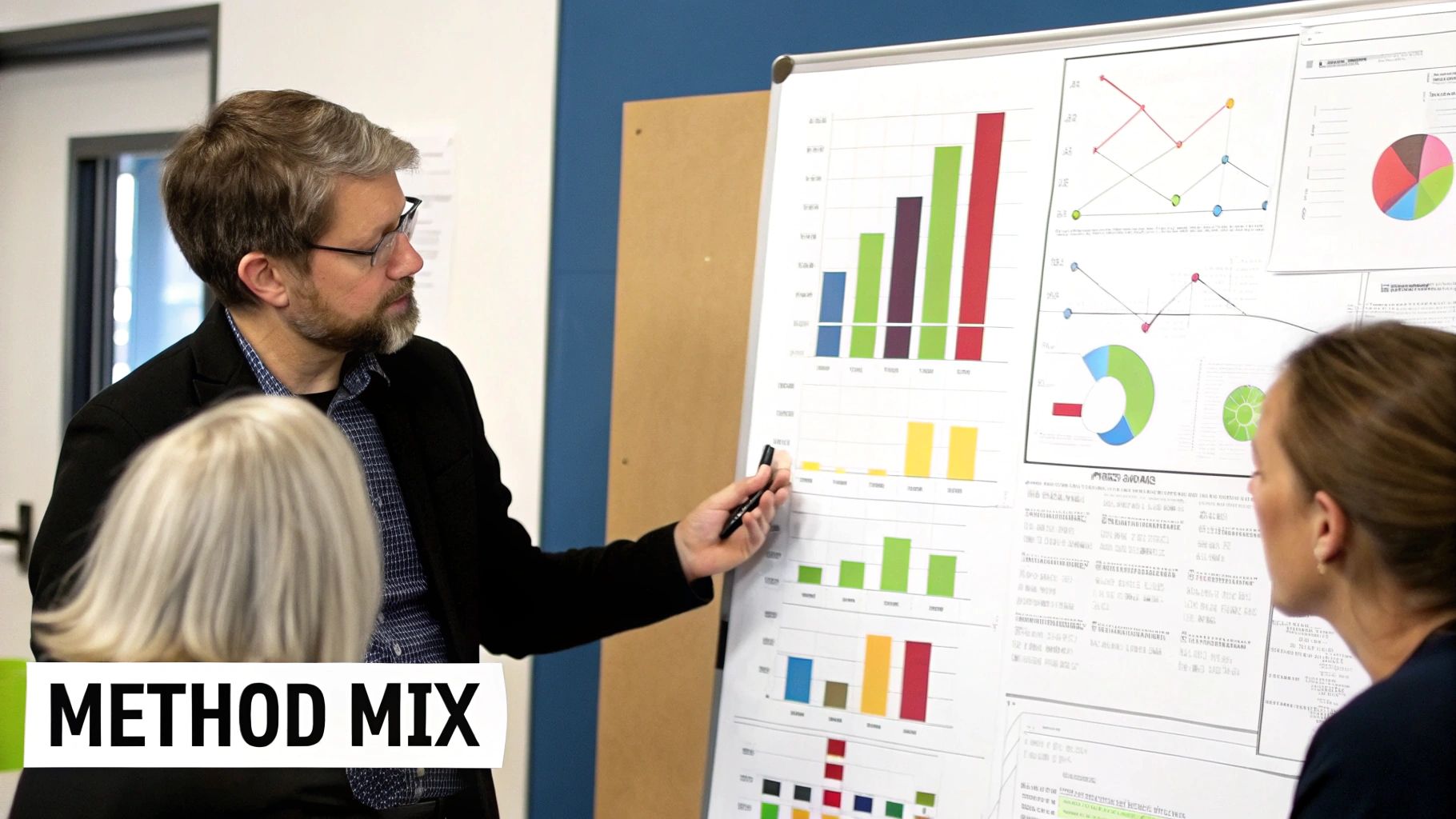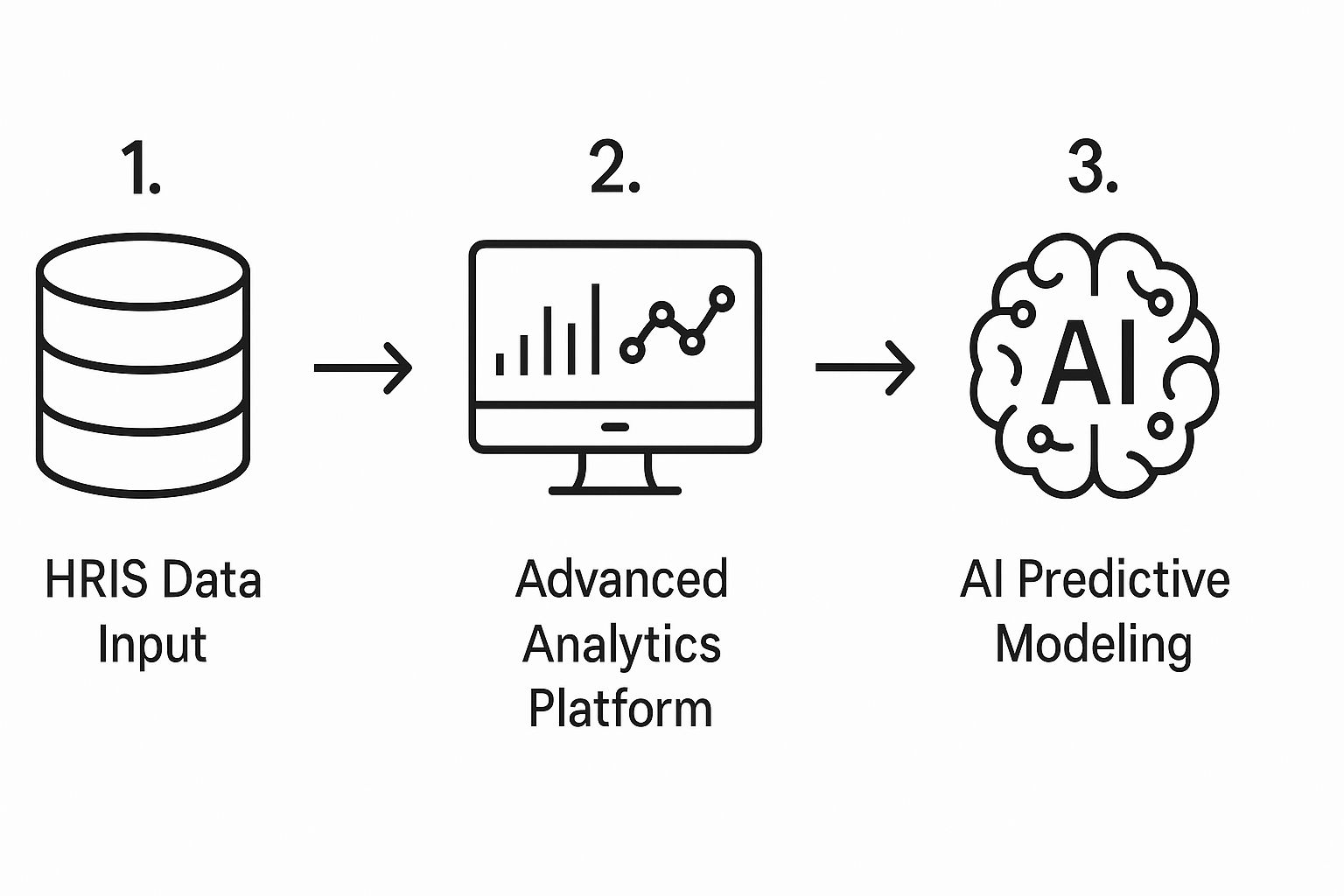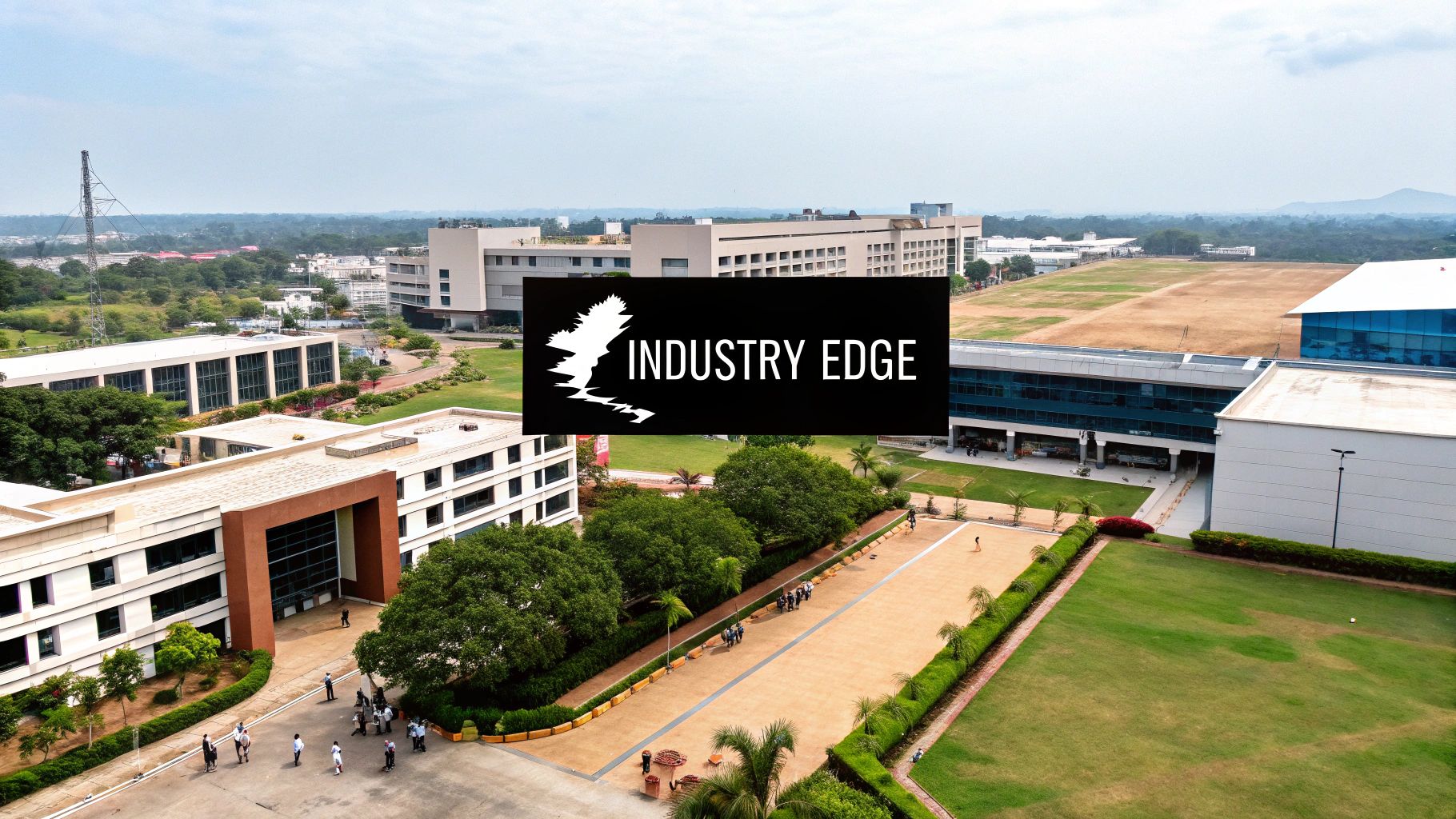Think about trying to navigate a ship across the vast ocean, but without a map, a compass, or even a weather report. You might eventually hit land, but it probably won’t be where you intended to go, and the journey will almost certainly be a chaotic one.
That’s what running a business feels like without a solid workforce forecast. It’s more than just an HR metric; it’s your strategic compass in a constantly changing business world.
Why Workforce Forecasting Is a Strategic Imperative

At its heart, workforce forecasting is the process of looking ahead to predict your organisation’s future talent needs. It’s about ensuring you have the right people with the right skills in the right roles at precisely the right time. This isn’t about gazing into a crystal ball; it’s a calculated analysis of historical data and current trends to align your talent strategy with your long-term business goals.
For CHROs, this is the key to shifting from a reactive hiring model to one of proactive talent cultivation. Instead of constantly scrambling to fill vacancies as they pop up, you can start anticipating your needs, spotting critical skill gaps before they become a crisis, and tying your people strategy directly to what the business wants to achieve.
The Shift from Reactive to Proactive HR
Implementing a forecasting model fundamentally changes how the HR function operates and contributes to the business. It moves the department from a support role to a strategic driver. Here’s a quick look at that transformation:
| Area of Focus | Reactive HR (Without Forecasting) | Proactive HR (With Forecasting) |
|---|---|---|
| Recruitment | Crisis-driven hiring to fill immediate, unexpected vacancies. | Strategic sourcing and building talent pipelines for future roles. |
| Skill Development | Addressing skill gaps only after they cause problems. | Identifying future skill needs and upskilling current employees ahead of time. |
| Cost Management | Incurs high costs from rushed recruitment and over/understaffing. | Optimises labour costs by aligning headcount with business demand. |
| Business Strategy | HR operates separately from core business planning. | Talent strategy is fully integrated with and supports business objectives. |
| Risk Management | Vulnerable to market shifts and talent shortages. | Mitigates risks by preparing the workforce for future challenges. |
This shift ensures your HR team isn’t just filling seats but is actively building the workforce your company needs to win in the future.
Connecting Talent to Business Outcomes
When done right, forecasting ensures your organisation is always one step ahead. This forward-looking approach is critical for several reasons:
- Seizing Market Opportunities: Having the right talent on standby means you can jump on new business ventures or adapt to market shifts without delay.
- Mitigating Risks: You can proactively tackle potential talent shortages or surpluses, preventing the operational hiccups and lost productivity that come with them.
- Optimising Labour Costs: It helps you strike the right balance, avoiding the inflated costs of overstaffing and the burnout and missed targets caused by understaffing.
The global employment landscape is in constant motion. The World Economic Forum predicts a net increase of 78 million jobs worldwide by 2030, with India poised to be a major beneficiary. The real challenge, however, is that 39% of core job skills are expected to change by then. The game is no longer just about filling roles; it’s about building a workforce with the right skills for tomorrow. You can explore more on the future of jobs and skills in India to understand the shifting landscape.
By forecasting talent needs, you transform the HR function from an administrative cost centre into a strategic partner that drives growth and builds a resilient, future-ready organisation.
Exploring Core Workforce Forecasting Methodologies

There’s no single, magical crystal ball for effective workforce forecasting. The reality is that it’s more like having a well-equipped toolbox. Different situations call for different tools, and knowing which method to pick is the key to blending art and science for the most accurate predictions.
These approaches generally fall into two buckets: quantitative and qualitative. Think of quantitative methods as using a telescope to look back at historical data, projecting past patterns into the future. Qualitative methods, on the other hand, are more like using a compass and map—relying on expert judgment to navigate what lies ahead.
Data-Driven Quantitative Methods
Quantitative forecasting is all about the numbers. It leans on hard data to spot trends and relationships, making it an objective and powerful approach, especially in stable environments where the past is a good indicator of the future.
Here are a couple of common methods:
- Trend Analysis: This is the most straightforward of the bunch. You simply look at historical staffing data—things like hiring rates, turnover, and departmental growth over the last five years—to predict what’s next. If your sales team has consistently grown by 10% year-over-year, trend analysis suggests you’ll need a similar boost next year.
- Ratio Analysis: This technique gets a bit more specific by linking staffing levels directly to business metrics. For example, you might determine you need one HR business partner for every 100 employees, or one customer service agent for every 500 customers. As those business metrics climb, you can precisely forecast the headcount increase required to keep up.
These methods give you a solid, data-backed foundation. In a dynamic economy, this kind of data-centric approach is vital. Take India, for example, where the Labour Force Participation Rate (LFPR) has jumped from 49.8% in 2017–18 to 60.1% in 2023–24. Grasping these larger labour trends gives crucial context to your own internal data. You can read more about India’s evolving workforce dynamics to see just how this can impact talent availability.
Insight-Led Qualitative Methods
What happens when historical data isn’t available or simply can’t be trusted? This is common when you’re launching a new product line or stepping into a completely new market. This is where qualitative methods, which draw on human expertise and judgement, really shine.
These methods are less about nailing down precise numbers and more about setting a strategic direction. They help you prepare for several potential futures rather than betting on a single outcome.
A couple of key qualitative approaches include:
- The Delphi Technique: This involves anonymously polling a panel of internal or external experts. Their insights are gathered, summarised, and then shared back with the group for more feedback. This cycle continues until a consensus emerges, which helps sidestep groupthink and taps into collective wisdom—perfect for forecasting needs for brand-new, specialised roles.
- Scenario Planning: With this method, you map out detailed stories for a few possible futures—think best-case, worst-case, and most-likely scenarios. By thinking through different outcomes, you build organisational resilience and can develop flexible talent strategies that are ready to adapt no matter what the market throws at you.
Ultimately, the most powerful workforce forecasting strategy is often a hybrid. It starts with a quantitative baseline and then layers on qualitative insights from leadership and industry experts. This blend ensures your forecast is both grounded in reality and strategically prepared for the future.
Essential Tools and Technologies for Modern Forecasting
While the core ideas behind workforce forecasting haven’t changed, the tools we use to do it have been completely transformed. Technology has taken forecasting from a static, yearly chore to a dynamic, real-time strategic function. It offers a level of speed and precision that was simply out of reach before.
Any modern forecasting effort really starts with a solid Human Resource Information System (HRIS). Think of your HRIS as the central nervous system for all your people data—it holds everything from headcount and turnover rates to employee skills and performance reviews. Many of the more advanced HRIS platforms now come with their own forecasting modules, giving you a powerful launchpad for your analysis.
Advanced Analytics and Predictive Modelling
To take your forecasting to the next level, you need to look beyond standard HRIS reports and start using advanced analytics platforms. These tools pull in data from multiple places—HR, finance, sales—to give you a complete picture of your organisation’s health. They let you see trends, model different business scenarios, and truly understand what’s driving your talent needs.
But the real game-changer is bringing Artificial Intelligence (AI) and Machine Learning (ML) into the mix. These technologies can sift through huge amounts of data to spot complex patterns that a person could easily miss.
- Predicting Turnover: AI algorithms can look at factors like an employee’s commute time, their manager’s feedback, and how long they’ve been with the company to predict who is at high risk of leaving. This allows you to step in with retention efforts before it’s too late.
- Identifying Skill Gaps: ML models can scan upcoming project needs and current market trends to forecast what skills you’ll need in the future, helping you shape your training and hiring plans.
- Optimising Recruitment: By analysing what made past hires successful, AI can help you zero in on the best sourcing channels and improve how you select candidates, ensuring a better fit for new roles. You can find more details in our guide on digital RPO for high-impact hiring.
By automating the analysis of complex variables, AI transforms workforce forecasting from a reactive report into a predictive, strategic asset. It helps answer not just what happened, but why it happened and what is likely to happen next.
Despite some fears about job displacement, most see AI as a powerful partner. In fact, 87% of Indian employers don’t expect AI to have a significant negative impact on jobs, and 13% actually see it creating new roles in areas like IT and analytics. This points to a future where technology doesn’t replace human strategy but amplifies it. You can learn more about how AI is shaping India’s job outlook on timesofindia.indiatimes.com.
By embracing these modern tools, organisations can build a far more resilient and forward-thinking talent strategy.
Putting Your Workforce Forecasting Process into Action
Let’s be honest, moving from theory to practice is where the real magic happens with workforce forecasting. The good news is that creating an effective process doesn’t have to be a monumental task. When you break it down into a clear, actionable roadmap, you can build a system that syncs your talent strategy directly with your company’s biggest goals.
The journey starts by getting a firm grip on where your organisation is today and, more importantly, where it’s headed tomorrow. Each step logically builds on the one before it, giving you a complete picture of your talent landscape.
This visual captures the essence of the process: turning raw HR data into sharp, predictive insights for smarter strategic planning.

What this really highlights is the shift away from just collecting data to actively using it to model future workforce scenarios with impressive accuracy.
Step 1: Pinpoint Your Strategic Business Goals
Before you even think about crunching numbers, you need to know which way the business is sailing. Your workforce forecast is only as good as its connection to core organisational goals. Are you planning to expand into new markets? Launch a groundbreaking product line? Or perhaps drive a company-wide digital overhaul?
You have to ask the tough questions: What are our revenue targets over the next three years? Which new technologies are going to shake up our operations? What does our growth roadmap look like? The answers to these questions are the bedrock of your entire forecast. Without this strategic alignment, you risk your efforts becoming a purely academic exercise with little real-world impact.
Step 2: Get a Handle on Your Current Workforce
With your goals set, it’s time to take a detailed snapshot of the team you have right now. This is much more than a simple headcount. You need to build a comprehensive skills inventory—a catalogue of the competencies, qualifications, and untapped potential of your people.
Your analysis should uncover:
- Key Roles and Talent Hotspots: Who are the high-flyers and subject matter experts you can’t afford to lose?
- Existing Skill Gaps: Where are the capabilities missing that you’ll need for your future goals?
- Attrition Risks: Are there specific departments or roles with a revolving door that you need to account for?
Think of this internal audit as establishing your baseline. It shows you what you’re working with before you can figure out what you’ll need down the line.
Step 3: Forecast Your Future Talent Demand
Now for the forward-looking part. This is where you blend your strategic goals with historical data and market trends to predict what you’ll need in the future. You’re essentially forecasting the demand for talent. If the company aims to boost production by 20%, how many more operations managers does that translate to? If you’re launching a new AI-powered service, what specific data science skills will suddenly become non-negotiable?
The best approach is to use a mix of quantitative methods, like trend analysis, alongside qualitative insights gathered straight from department leaders. This step is all about translating those big-picture business objectives into tangible headcount and skill requirements.
By forecasting demand, you shift from being reactive—scrambling to fill roles as they open up—to proactively building the exact workforce needed to drive future business strategy. That proactive stance is a massive competitive advantage.
Step 4: Identify and Bridge the Talent Gaps
The final piece of the puzzle is comparing your future demand forecast with your current workforce analysis. That space between what you have and what you need? That’s your talent gap. This gap analysis is the most crucial output of the entire process because it directly informs your plan of attack.
Once you’ve identified the gaps, you can get to work developing targeted strategies to close them. Your action plan might include a mix of tactics:
- Targeted Recruiting: Sourcing external candidates who already have the specific skills you’re missing.
- Internal Mobility Programmes: Promoting and moving talented employees into new roles where they can grow.
- Strategic Reskilling Initiatives: Training current team members to get them ready for the responsibilities of tomorrow.
This strategic plan ensures you’re not just hiring people, but methodically building the precise workforce your organisation needs to win.
How Indian Industries Apply Workforce Forecasting

Theories and models are a great starting point, but the real magic of workforce forecasting happens when it’s used to solve tangible business challenges. Across India, smart companies are using this strategic tool not just to manage their headcount, but to build a serious competitive edge.
These real-world examples show forecasting in action, turning predictive insights into powerful business outcomes. From the fast-paced IT corridors to bustling manufacturing hubs, the applications are as diverse as the industries themselves. Each sector faces its own unique talent pressures, and forecasting provides the lens to anticipate and tackle them head-on.
IT Sector Proactively Managing Skill Demand
India’s IT industry is the poster child for rapid evolution. A major technology services company, for instance, was facing a huge problem: the explosive demand for niche skills in Artificial Intelligence and Cybersecurity was far outpacing the available talent. Relying on last-minute hiring was causing project delays and sending recruitment costs through the roof.
Using a mix of trend analysis and scenario planning, their HR team started forecasting the demand for these specific skills 12-18 months in advance. This foresight was a game-changer. It allowed them to:
- Launch targeted upskilling programmes for their current employees.
- Build strategic partnerships with universities to create a future talent pipeline.
- Adjust salary benchmarks to attract and keep top experts in these high-demand fields.
This proactive approach drastically cut down their time-to-hire for critical roles and ensured project teams had the right people at the right time. Understanding this shifting landscape, which is often highlighted in reports like the India Skills Report, is absolutely vital for this kind of forward-thinking planning.
Manufacturing and Retail Sector Applications
Forecasting isn’t just for the tech world. It delivers immense value in more traditional sectors by helping them navigate operational and growth challenges. These industries often grapple with seasonality, succession planning, and rapid expansion, where having the right number of people is make-or-break.
By looking ahead, these companies move beyond simple headcount management. They strategically align their talent resources with operational cycles and long-term growth ambitions, ensuring stability and readiness for future opportunities.
Let’s look at a few examples. The following table breaks down how specific forecasting goals lead to concrete actions in key Indian sectors.
| Industry Sector | Primary Forecasting Goal | Strategic Action Taken |
|---|---|---|
| Automotive Manufacturing | Predict seasonal labour needs tied to production cycles and festival demand. | Optimise contract workforce management to avoid bottlenecks and control costs during peak seasons. |
| Fast-Growing Retail Chain | Map out talent requirements for 50 new stores over two years. | Stagger recruitment and training initiatives by region to ensure each new store opens with a fully prepared team. |
| Pharmaceuticals | Identify future leadership gaps in critical R&D and quality control roles. | Develop a robust succession plan by grooming high-potential internal candidates well in advance. |
| Logistics & Supply Chain | Forecast driver and warehouse staff needs based on e-commerce sales peaks. | Implement flexible staffing models and targeted hiring campaigns before major shopping seasons. |
These practical applications show that workforce forecasting is a versatile and powerful tool. It enables organisations of all kinds to build the skilled, agile, and resilient workforce they need to not just survive, but thrive.
Navigating Common Forecasting Challenges
Kicking off a workforce forecasting initiative is a huge strategic win, but let’s be honest—it’s rarely a straight line from A to B. CHROs often run into the same familiar roadblocks that can stall momentum right out of the gate. But with a bit of foresight, these challenges are entirely manageable.
One of the biggest culprits is poor data quality. If your HRIS data is inaccurate, incomplete, or just plain messy, your entire forecast is built on a shaky foundation. Garbage in, garbage out, as they say. Unreliable data leads to flawed predictions, making it incredibly difficult to build a credible case for your talent strategies.
Another major hurdle? Getting leadership to care. Too often, executives dismiss forecasting as a theoretical HR exercise, failing to see how it connects to the bottom line and mitigates real business risks. Without their backing, securing the resources and cross-departmental support you need is an uphill battle.
Overcoming Forecasting Obstacles
The trick to navigating these issues is to be strategic. It’s about showing value early and speaking the language of the C-suite.
- Start with a Pilot Project: Instead of trying to boil the ocean with a company-wide forecast, start small. Pick a single department and run a focused pilot project. A successful pilot gives you tangible results and a powerful story to win over the sceptics.
- Translate Insights into Impact: Don’t just present numbers; present outcomes. Frame your findings in terms of financial impact. Show them how proactively closing a skills gap will slash recruitment costs by 15% or how smarter scheduling will boost productivity.
The key is to connect your workforce forecast directly to business outcomes. When you can show how anticipating talent needs prevents operational disruptions or supports revenue growth, forecasting transforms from an HR metric into a critical business tool.
Then there’s the challenge of predicting disruptive technologies, which can feel like trying to hit a moving target. The pace of change is so fast that it’s tough to know which skills will be critical in three, let alone five, years. This uncertainty can easily lead to analysis paralysis, stopping you from taking any action at all.
The answer is to build an agile talent strategy. Instead of placing all your bets on one specific technology, focus on fostering a culture of continuous learning. A proactive stance also helps you manage risks like key people leaving unexpectedly. You can dive deeper into an overview of employee attrition and how to prevent it to build that resilience into your plans. By preparing for a range of possible scenarios, you give your organisation the flexibility to adapt and thrive, no matter what the future holds.
Ready to build a future-ready workforce with precision and foresight? Taggd specialises in Recruitment Process Outsourcing that aligns your talent strategy with your business goals.








